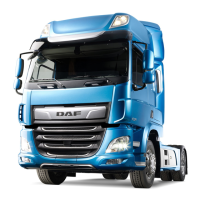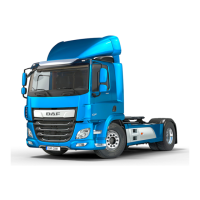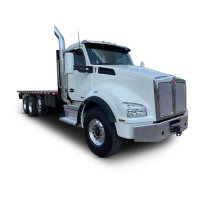
Do you have a question about the Paccar DAF CF and is the answer not in the manual?
Explains warning symbols and their meanings, including risk of personal injury or material damage.
Provides a short explanation of frequently mentioned system abbreviations used throughout the driver manual.
Covers essential checks and preparations required before starting to drive the vehicle.
Highlights crucial safety regulations that must be observed to avoid serious injury or vehicle damage.
Details safety precautions for vehicles equipped with airbags and safety belt tensioner systems.
Provides critical instructions to prevent vehicle damage, focusing on original components and system voltage.
Explains the privacy notice regarding data collected by the vehicle's connected truck device and data logger.
Introduces the DAF theft protection system, outlining its various protective forms for the vehicle.
Describes the function of the immobiliser, which prevents the engine from starting without the correct ignition key.
Details how the ALS-S alarm system operates, including activation, self-diagnosis, and use when staying in the cabin.
Explains the optional night lock, providing an additional mechanical lock on the doors for enhanced security.
Covers the different types of cabins and interior features, including entry/exit, doors, and various controls.
Provides instructions on adjusting seats for proper seating position and the importance and use of safety belts.
Details the dashboard switch layout, instrument panel components, and various control panels and their functions.
Explains the telephone interface, activation of the truck phone, Bluetooth pairing, and operating the telephone via steering wheel switches.
Describes the basic radio controls, input connections, USB connections, and the Truck Navigation Radio (TNR).
Explains the heating, ventilation, and air conditioning system, including air distribution and climate control panel operations.
Details the operation of auxiliary heaters, including rest heat usage, park ventilation, and cylinder block heaters.
Provides an overview of the master display's components, including the indication bar and interactive dialogue area.
Explains the different areas of the master display, messages, warnings, and the function of the Menu Control Switch.
Describes the start-up screen shown on the master display when the ignition is switched on and the engine is not running.
Explains how to navigate the vehicle's menus using the Menu Control Switch, including selecting options and changing values.
Provides a detailed overview of the main menus, sub-menus, and their corresponding information and settings.
Explains how system warnings are displayed, including serious and less serious faults, and their associated icons and meanings.
Details various warning indicators displayed on the master display, covering systems like EBS, ABS, and general warnings.
Illustrates and explains various warning indicators found on the instrument panel, categorized by their location and function.
Outlines the driver's daily and weekly checks, covering lights, instruments, fluid levels, and tyre condition.
Provides information on general vehicle maintenance, cabin maintenance, and cleaning procedures for the vehicle's exterior and interior.
Gives detailed instructions on how to clean the vehicle, including best practices for using cleaners and high-pressure equipment.
Explains how to open and close the fender to create extra space between the cabin and the semi-trailer.
Provides general guidelines and warnings regarding the fifth wheel, including coupling and uncoupling procedures.
Details the procedures for coupling and uncoupling trailers, including safety warnings and connection of brake pipes and lights.
Explains how to connect the brake pipes using automatic coupling heads, emphasizing correct connection for safety.
Describes how to connect the ABS/EBS connector of a trailer to the truck's system and the consequences of not connecting it.
Explains how to connect the lighting of the trailed vehicle using the 7-pin sockets and potential power limitations.
Emphasizes performing daily and weekly checks before starting a drive to ensure vehicle readiness and safety.
Provides essential safety precautions and guidelines for refuelling diesel and refilling AdBlue, including fuel quality and additives.
Details the procedure for starting the engine, including glowing, checks, and handling potential warnings or issues.
Explains the correct procedure for stopping the vehicle, including applying the park brake and parking safely.
Describes the DPF regeneration process, its three levels, driving conditions, and how to stop or manage regeneration.
Explains the DPA feature, which provides feedback to the driver on vehicle handling, driving style, and fuel consumption.
Details how to access and interpret fuel consumption information, including setting fuel consumption targets for better economy.
Explains the automatic engine idle shutdown feature, its activation conditions, and restarting the engine.
Describes how to engage and disengage Engine Speed Control, including accelerator pedal function and conditions for use.
Explains the function of cruise control, including Adaptive Cruise Control (ACC) and Predictive Cruise Control (PCC).
Details how to use the variable speed limiter to set a speed limit and how it interacts with cruise control.
Explains how to increase traction using trailing or leading rear axles and the conditions for engaging and disengaging traction aid.
Describes the types of differential locks and provides directions for their use, emphasizing caution to prevent damage.
Explains the conditions for switching the PTO on or off, covering both gearbox and engine PTO types.
Covers the park brake, service brake, EBS system, ABS control, brake assist, and brake performance monitoring.
Details the engine brake (exhaust brake or MX Engine Brake), its brake effect, and operational instructions for manual and automated gearboxes.
Explains the retarder's function, warning about its limitations, and providing instructions for engaging and disengaging it.
Introduces detection devices like cameras and radar sensors used to assist vehicle systems in recognising situations.
Explains Adaptive Cruise Control (ACC), including its introduction, engaging/disengaging conditions, and speed adaptation.
Details the AEBS, its introduction, sensitivity, detection and intervention levels, and how to engage/disengage it.
Explains Anti Slip Regulation (ASR), its function in preventing wheel slip, and conditions for increased wheel slip.
Describes Downhill Speed Control (DSC), its function in maintaining speed limits during descents, and engaging/disengaging conditions.
Explains the Eco Mode function for reducing fuel consumption by optimizing acceleration and torque, and its operation with different gearboxes.
Details the EcoRoll function of the automated gearbox designed to increase fuel savings by gaining momentum on descents.
Explains Forward Collision Warning (FCW), its engagement, and the warnings generated when distance to an object ahead is not maintained.
Describes Hill Start Aid, its function for driving off on hills without the park brake, and engaging/disengaging conditions.
Explains the LDWS, which warns the driver of unintentional lane departures using a windscreen camera.
Details Predictive Cruise Control (PCC), its ability to interpret road topography for speed adaptation and fuel saving.
Explains Tyre Pressure Indication (TPI), how it monitors tyre pressure without direct measurement, and TPI warnings.
Describes Tyre Pressure Monitoring (TPM), its functions including tyre pressure and temperature monitoring, and TPM warnings.
Explains the Vehicle Stability Control (VSC) system, its role in stabilizing the vehicle in critical situations, and intervention warnings.
Provides general recommendations for preventing wear and burning of the clutch when driving off and changing gears.
Details the 16-speed gearbox, its four ratios, two speed ranges, and the function of the splitter box for splitting gears.
Explains how to change between low and high speed ranges using the switch on the gear change lever, including caution for gate protection.
Describes how to change half gears (splitting) using the switch on the side of the gear change lever.
Offers recommendations for favourable economies when driving on gradients, including when to shift up or down.
Explains the clutch protection system that prevents driving off in incorrect gears and the warning for 'Drive-off gear too high'.
Introduces the TraXon automated gearbox, its electronic control system, and its operating modes and features.
Details how to drive off on a flat road, including drive-off protection, load detection, and driving off in reverse.
Explains automatic gear control, including selecting modes, managing Eco Mode, and how the gearbox behaves under certain conditions.
Describes how to manually control gears using the steering column switch, including shifting up/down and conditions for manual shifting.
Explains the forward and reverse manoeuvring modes, including cautions about clutch slipping and potential damage.
Provides guidance on driving off and driving on a gradient, including the use of park brake, Hill Start Aid, and engine brake/retarder.
Details the off-road mode for heavy terrain conditions, its features, and how it affects driving and ASR control.
Explains the liquid transport application software for tanker transport, modifying gear shift timing and selection.
Describes clutch protection features, flashing gear indication, overload warnings, and how to relieve clutch overload.
Details the Allison 3000 series automatic gearbox, its operation via selector keypad, and functions like gear selection and shift programs.
Explains transmission fault warnings, including oil temperature issues and general transmission warnings, and troubleshooting steps.
Introduces the Electronically Controlled Air Suspension (ECAS) system and the use of the remote control unit for operating vehicle height.
Describes the basic and extended remote controls, their buttons, and how to activate/deactivate functions like chassis height adjustment.
Explains how to engage the air suspension system using the remote control keys and how to cancel choices or stop adjustments.
Details the function of the 'Stop' key on the remote control unit, which cuts out electropneumatic valves for chassis height adjustment.
Describes how to program memory keys (M keys) to set the chassis to a desired height for specific situations.
Explains the Axle Load Monitoring system, how to view axle loads and payload, and the conditions for displaying axle load information.
Provides instructions on performing axle load calibration, including when it is necessary and how to use the remote control for calibration.
Details the procedure and safety warnings for tilting the cabin, including precautions to prevent injury or damage.
Provides instructions for checking, removing, and installing the poly-V-belt on the MX-13 and MX-11 engines.
Gives emergency instructions for starting the engine after the fuel tank has run dry, emphasizing a lengthy starting procedure.
Explains the ZF gearbox low-range protection and what to do if the low range cannot be used due to a failure.
Provides instructions and warnings for releasing the park brake, especially on inclines, and how to bring the park brake back into operation.
Describes the self-braking wheel winch used for lowering the spare wheel.
Details the correct procedure and safety warnings for jacking up the leaf-sprung front axle.
Explains the correct procedure and safety warnings for jacking up the air sprung front axle.
Provides instructions and safety warnings for jacking up the rear axle of the vehicle.
Details the procedure for removing and installing wheels, including safety warnings and tips for cleaning and tightening wheel nuts.
Locates the tyre inflating connections and explains how to use them for inflating tyres or the air pressure system.
Provides instructions and warnings for towing and being towed, including towing hooks, disconnection of prop shafts, and disabling driver assist systems.
Explains the procedure for jump-starting the vehicle using starter cables, including battery systems and cautions about voltage and disconnection.
Details how to charge batteries, including safety warnings for charging and different battery box types.
Provides instructions for replacing main and dipped beam, indicator lights, front fog/cornering lights, and rear lights.
Explains fuse replacement procedures, safety precautions, fuse box layout, and fuse colour-coding.
Presents technical data for the MX-13 and MX-11 engines, including output, torque, lubrication system, and emission standards.
Details the vehicle's electrical system, including voltage, battery system, bulb specifications, and battery ignition key.
Provides a legend of symbols found on the fuse box label, identifying various vehicle systems and components.
Covers wheel specifications, including tightening torque, inspection torque, and warnings related to loose wheels.
Explains tyre indication, including type, size, load index, speed index, and tyre pressure information.
Specifies the correct lubricants, coolant, AdBlue, and fuel requirements to ensure durability and warranty compliance.
Details AdBlue specifications, handling precautions, storage instructions, and the consequences of using incorrect or contaminated AdBlue.
Provides information on engine oil specifications, including international standards and viscosity requirements.
Explains coolant specifications, safety precautions for handling coolant, and its environmental impact.
Specifies approved and permitted diesel fuels, including regular diesel, alternative fuels, and cautions regarding fuel additives.
Specifies the type of fluid used for the hydraulic clutch.
Details the type of oil required for the steering box and hydraulic power steering.
Specifies the type of gear oil required for the cabin tilting mechanism.
Covers chassis number identification and the vehicle identification plate, including its location and contents.
Explains where the chassis number (Vehicle Identification Number) is stamped and how it can be displayed on the master display.
Describes the location and information found on the vehicle identification plate attached to the right-hand door pillar.
Indicates the location of the paint identification plate within the cabin.
Shows the location of the engine number on both MX-13 and MX-11 engines.
Describes the location and information found on the engine identification plate.
Provides CE information, including Declaration of Conformity for the telephone interface and technical specifications.









